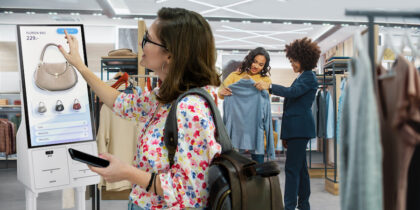Data is the new currency of retail, and in 2019, stores will play a new role in capturing and accessing data to deliver an elevated customer experience.
Formerly data-dark stores are now shining in brightness thanks to new points of data collection, such as Internet of Things (IoT) sensors, cameras, mobile devices and in-store analytics that empower retailers to act quickly on what they learn. Amazon Go stores, for example, are considered to be as much about testing and learning about customers as they are about fast, cashier-less shopping.
All this new data gives retailers unprecedented control over what happens in their stores. They can track the effectiveness of store design and display, test new marketing and customer engagement strategies and establish a culture of continuous improvement based on their ever-expanding knowledge of customer preferences and behaviors, for example.
Here are some of the trends that mark data’s role in the present and future of technology in retail.
IoT Data Collection
IoT will play a key role in transforming the store floor by putting points of data collection in places where retailers had no visibility before. Global Market Insights forecasts the retail IoT market will reach over $30 billion by 2024. By embedding sensors across the store floor, on carts, shelves, racks and even on employees, retailers are able to gather information such as foot traffic, shopper demographics and inventory movement. This enables applications like real-time inventory for click-and-collect, in-store navigation and tailored promotions, delivering personalized experiences on digital displays.
Edge Processing for Real-Time and Long-Term Customer Relationships
Just as in-store shopping occurs in real time, so must the data-fueled tools that enhance the store experience. Retailers are leveraging edge and fog computing to place compute power closer to the shopper, so they can perform the quick analytics needed for a variety of tasks without latency or bandwidth issues. In fact, Gartner predicts that by 2022, 75 percent of enterprise-generated data will be created and processed outside a traditional centralized data center or cloud.
Transform Retail Associate Performance
Get your free guide to empowering retail associates with mobile devices and data. Download Now
Edge computing supports store activities through technologies like AR-supported digital mirrors, which allow customers to virtually try on different outfits, or by collecting beacon data to generate heat maps of customer activity in real time. Retailers are also looking to leverage edge technologies that make all data look like local data. This allows them to process both real-time and stored data together — such as customer history and preferences — which drives personalization, tailored promotions and bespoke experiences.
Data-Based Store Design
Shopping basket data only tells retailers what consumers ultimately decided to buy. But when retailers can measure things like dwell time, products that were picked up and put back, or the demographics of those stopping to watch digital content or try a product sample, they can understand what opportunities they’re missing.
Thanks to all the new data generated by cameras and sensors, retailers can augment current data sources like transaction data and customer surveys with new insights to discover new patterns and test and learn from store design and display ideas. “Data can then be applied to a number of both promotional and physical re-merchandising scenarios that target a company’s best customers,” according to Retail Customer Experience.
Customer Engagement Innovation
According to Forrester, retailing is now all about “obsessing about your customer’s experience.” To get there, “organizations must remove silo shackles to unify disparate data to develop deep customer insights.” While today’s retailers have their own ways to measure and act on consumer data between marketing, sales and social media engagement, increasingly they will need integrated platforms supported by robust AI and analytics capabilities to take a more holistic approach.
Gartner reports that “an understanding of the overall condition of the customer’s attitude toward the enterprise is lacking for the majority. What matters is not the customer’s attitude about a store, department, process or product, but the level of trust they have in the organization as a whole and their likely intent to remain loyal.” Gartner predicts that by 2020, more than 40 percent of all data analytics projects will relate to an aspect of customer experience.
Delivering Insights to Associate Mobile Devices
The more an associate knows about an individual customer’s needs, the better service the associate can provide. That’s driving a huge uptick in investment in associate mobile devices, as well as analytics investments that enable retailers to process new data in real-time. By 2020, most retailers (83 percent) will have mobile devices for store associates or managers, according to RIS News’ 2018 Retail Technology Study.
These devices will leverage an increasingly robust array of data sources to enrich the quality of that service. By 2025, for example, 74 percent of retailers envision using geolocation devices to recognize a shopper as they arrive at a store. A store associate can then welcome them, already armed with insights such as the shopper’s recent searches on the retailer’s website and purchase history. This allows a quick, easy and enjoyable shopping experience for the customer.
As those edge technologies proliferate, so does the complexity of managing and securing them. As they plan and build out their in-store analytics and data collection infrastructure, savvy retailers are also implementing powerful tools such as Samsung Knox to manage and monitor corporate devices and data traffic usage. Not only does Knox ensure data is readily available on applications and devices, but also that it remains protected and encrypted to prevent leakage. It also ensures retailers always know the location of devices, as well as their health and usage patterns, so they can be remotely managed via tools like Samsung E-FOTA to ensure they are operating at peak efficiency.
Retail has a long history of relying on gut instinct and merchandising art to understand and serve customers, with data playing a supporting role. But now, retail is in the throes of a rapid shift from data-generating to data-centric. Among the most prominent retail trends of 2019 will be the ways data and analytics start delivering real value in supporting retailers’ store-level, data-fueled transformation.
To schedule a discussion of retail technology with Samsung at NRF, please provide your contact information.








